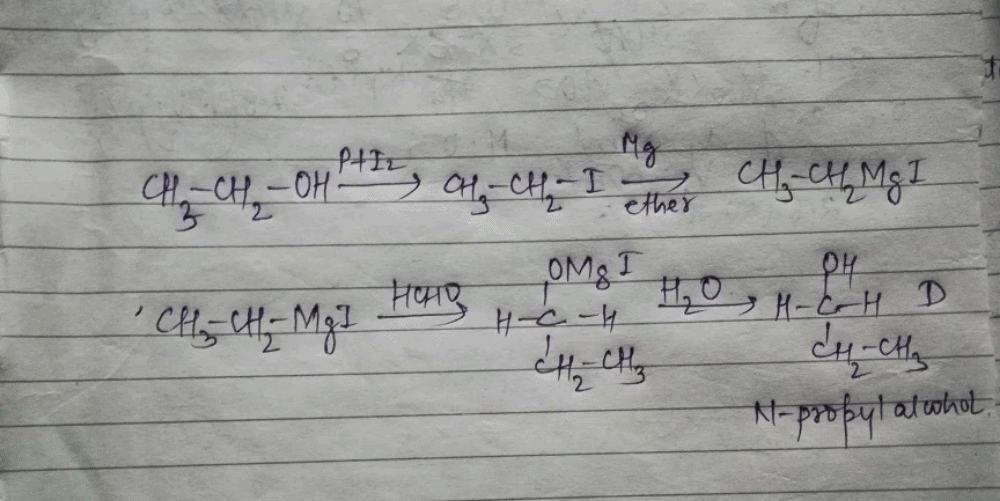Class 12 Exam > Class 12 Questions > In the following sequence of reactions, CH3CH...
Start Learning for Free
In the following sequence of reactions, CH3CH2OH A
A  B
B  C
C  D, then compound `D' is - [AIEEE 2007]
D, then compound `D' is - [AIEEE 2007]
- a)Butanal
- b)N-butyl alcohol
- c)N-propyl alcohol
- d)Propanal
Correct answer is option 'C'. Can you explain this answer?
Verified Answer
In the following sequence of reactions, CH3CH2OHABCD, then compound `D...
Correct Answer is option C
When ethanol is treated with a mixture of phosphorus and iodine, ethyl iodide CH3CH2I is obtained.
Compound A on reaction with Mg metal in ether forms ethyl magnesium iodide CH3CH2 MgI.
The compound B reacts with formaldehyde to form compound C; CH3CH2−CH2−OMgX which on hydrolysis gives n propyl alcohol CH3CH2CH2−OH.
The compound D is n-propyl alcohol.
Hence, option C is correct.
When ethanol is treated with a mixture of phosphorus and iodine, ethyl iodide CH3CH2I is obtained.
Compound A on reaction with Mg metal in ether forms ethyl magnesium iodide CH3CH2 MgI.
The compound B reacts with formaldehyde to form compound C; CH3CH2−CH2−OMgX which on hydrolysis gives n propyl alcohol CH3CH2CH2−OH.
The compound D is n-propyl alcohol.
Hence, option C is correct.
Most Upvoted Answer
In the following sequence of reactions, CH3CH2OHABCD, then compound `D...

Free Test
FREE
| Start Free Test |
Community Answer
In the following sequence of reactions, CH3CH2OHABCD, then compound `D...
The compound A is Et-I B is Et-MgI C is Pr-OMgIAnd hence after hydrolysis compound D obtained is n propyl alcohol.

|
Explore Courses for Class 12 exam
|

|
Similar Class 12 Doubts
In the following sequence of reactions, CH3CH2OHABCD, then compound `D' is - [AIEEE 2007]a)Butanalb)N-butyl alcoholc)N-propyl alcohold)PropanalCorrect answer is option 'C'. Can you explain this answer?
Question Description
In the following sequence of reactions, CH3CH2OHABCD, then compound `D' is - [AIEEE 2007]a)Butanalb)N-butyl alcoholc)N-propyl alcohold)PropanalCorrect answer is option 'C'. Can you explain this answer? for Class 12 2025 is part of Class 12 preparation. The Question and answers have been prepared according to the Class 12 exam syllabus. Information about In the following sequence of reactions, CH3CH2OHABCD, then compound `D' is - [AIEEE 2007]a)Butanalb)N-butyl alcoholc)N-propyl alcohold)PropanalCorrect answer is option 'C'. Can you explain this answer? covers all topics & solutions for Class 12 2025 Exam. Find important definitions, questions, meanings, examples, exercises and tests below for In the following sequence of reactions, CH3CH2OHABCD, then compound `D' is - [AIEEE 2007]a)Butanalb)N-butyl alcoholc)N-propyl alcohold)PropanalCorrect answer is option 'C'. Can you explain this answer?.
In the following sequence of reactions, CH3CH2OHABCD, then compound `D' is - [AIEEE 2007]a)Butanalb)N-butyl alcoholc)N-propyl alcohold)PropanalCorrect answer is option 'C'. Can you explain this answer? for Class 12 2025 is part of Class 12 preparation. The Question and answers have been prepared according to the Class 12 exam syllabus. Information about In the following sequence of reactions, CH3CH2OHABCD, then compound `D' is - [AIEEE 2007]a)Butanalb)N-butyl alcoholc)N-propyl alcohold)PropanalCorrect answer is option 'C'. Can you explain this answer? covers all topics & solutions for Class 12 2025 Exam. Find important definitions, questions, meanings, examples, exercises and tests below for In the following sequence of reactions, CH3CH2OHABCD, then compound `D' is - [AIEEE 2007]a)Butanalb)N-butyl alcoholc)N-propyl alcohold)PropanalCorrect answer is option 'C'. Can you explain this answer?.
Solutions for In the following sequence of reactions, CH3CH2OHABCD, then compound `D' is - [AIEEE 2007]a)Butanalb)N-butyl alcoholc)N-propyl alcohold)PropanalCorrect answer is option 'C'. Can you explain this answer? in English & in Hindi are available as part of our courses for Class 12.
Download more important topics, notes, lectures and mock test series for Class 12 Exam by signing up for free.
Here you can find the meaning of In the following sequence of reactions, CH3CH2OHABCD, then compound `D' is - [AIEEE 2007]a)Butanalb)N-butyl alcoholc)N-propyl alcohold)PropanalCorrect answer is option 'C'. Can you explain this answer? defined & explained in the simplest way possible. Besides giving the explanation of
In the following sequence of reactions, CH3CH2OHABCD, then compound `D' is - [AIEEE 2007]a)Butanalb)N-butyl alcoholc)N-propyl alcohold)PropanalCorrect answer is option 'C'. Can you explain this answer?, a detailed solution for In the following sequence of reactions, CH3CH2OHABCD, then compound `D' is - [AIEEE 2007]a)Butanalb)N-butyl alcoholc)N-propyl alcohold)PropanalCorrect answer is option 'C'. Can you explain this answer? has been provided alongside types of In the following sequence of reactions, CH3CH2OHABCD, then compound `D' is - [AIEEE 2007]a)Butanalb)N-butyl alcoholc)N-propyl alcohold)PropanalCorrect answer is option 'C'. Can you explain this answer? theory, EduRev gives you an
ample number of questions to practice In the following sequence of reactions, CH3CH2OHABCD, then compound `D' is - [AIEEE 2007]a)Butanalb)N-butyl alcoholc)N-propyl alcohold)PropanalCorrect answer is option 'C'. Can you explain this answer? tests, examples and also practice Class 12 tests.

|
Explore Courses for Class 12 exam
|

|
Signup for Free!
Signup to see your scores go up within 7 days! Learn & Practice with 1000+ FREE Notes, Videos & Tests.





















